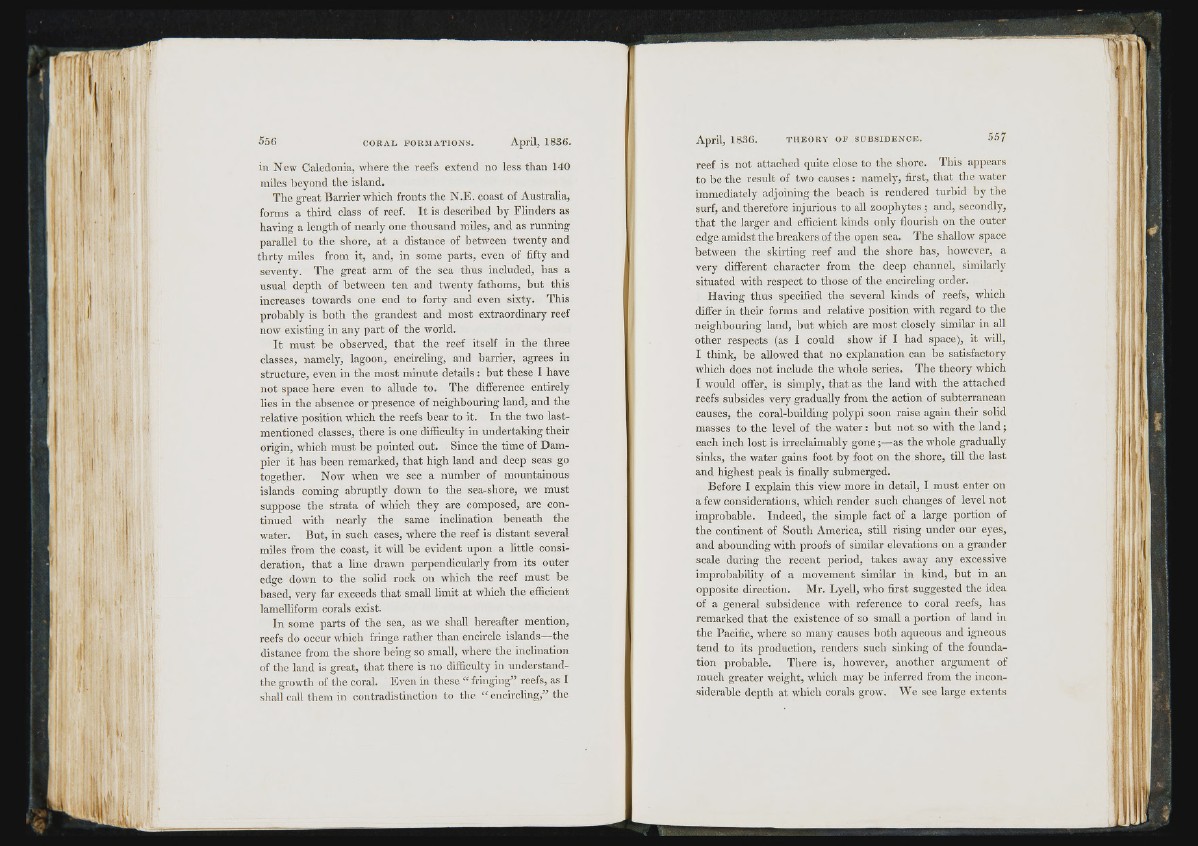
in New Caledonia, where the reefs extend no less than 140
miles beyond the island.
The great Barrier which fronts the N.E. coast of Australia,
forms a third class of reef. It is described by Flinders as
having a length of nearly one thousand miles, and as running-
parallel to the shore, at a distance of between twenty and
thrty miles from it, and, in some parts, even of fifty and
seventy. The great arm of the sea thus included, has a
usual depth of between ten and twenty fathoms, but this
increases towards one end to forty and even sixty. This
probably is both the grandest and most extraordinary reef
now existing in any part of the world.
It must be observed, that the reef itself in the three
classes, namely, lagoon, encircling, and barrier, agrees in
structure, even in the most minute details : but these I have
not space here even to allude to. The difference entirely
lies in the absence or presence of neighbouring land, and the
relative position which the reefs bear to it. In the two last-
mentioned classes, there is one difficulty in undertaking their
origin, which must he pointed out. Since the time of Dampier
it has been remarked, that high land and deep seas go
together. Now when we see a number of mountainous
islands coming abruptly down to the sea-shore, we must
suppose the strata of which they are composed, are continued
with nearly the same inclination beneath the
water. But, in such cases, where the reef is distant several
miles from the coast, it will be evident upon a little consideration,
that a line drawn perpendicularly from its outer
edge down to the solid rock on which the reef must be
based, very far exceeds that small limit at which the efficient
lamelliform corals exist.
In some parts of the sea, as we shall hereafter mention,
reefs do occur which fringe rather than encircle islands—the
distance from the shore being so small, where the inclination
of the land is great, that there is no difficulty in understand-
the growth of the coral. Even in these “ fringing” reefs, as I
shall call tliem in contradistinction to the “ encircling,” the
557
reef is not attached quite close to the shore. This appears
to be the result of two causes: namely, first, that the water
immediately adjoining the beach is rendered turbid by the
surf, and therefore injurious to all zoophytes ; and, secondly,
that the larger and efficient kinds only flourish on the outer
edge amidst the breakers of the open sea. The shallow space
between the skirting reef and the shore has, however, a
very different character from the deep channel, similarly
situated with respect to those of the encircling order.
Having thus specified the several kinds of reefs, which
differ in their forms and relative position with regard to the
neighbouring land, but which are most closely similar in all
other respects (as I could show if I had space), it will,
I think, be allowed that no explanation can be satisfactory
which does not include the whole series. The theory which
I would offer, is simply, that as the land with the attached
reefs subsides very gradually from the action of subterranean
causes, the coral-building polypi soon raise again their solid
masses to the level of the water : but not so with the land;
each inch lost is irreclaimably gone;—as the whole gradually
sinks, the water gains foot by foot on the shore, till the last
and highest peak is finally submerged.
Before I explain this view more in detail, I must enter on
a few considerations, which render such changes of level not
improbable. Indeed, the simple fact of a large portion of
the continent of South America, still rising under our eyes,
and abounding with proofs of similar elevations on a grander
scale during the recent period, takes away any excessive
improbability of a movement similar in kind, but in an
opposite direction. Mr. Lyell, who first suggested the idea
of a general subsidence with reference to coral reefs, has
remarked that the existence of so small a portion of land in
the Pacific, where so many causes both aqueous and igneous
tend to its production, renders such sinking of the foundation
probable. There is, however, another argument of
much greater weight, which may be inferred from the inconsiderable
depth at which corals grow. We see large extents
]i:i
i
i
11
J l
i d ;
i'l
IP